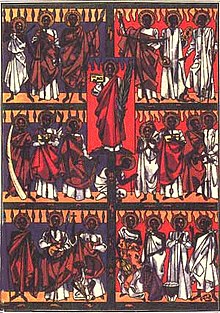The memorial of Charles Llwanga and his companion martyrs, put to death in Uganda between 1885 and 1887, has complex undertones: the conquest of Africa in the midst of the ‘scramble’ by various European powers; the struggle for converts amongst Catholicism, Anglicanism and Islam; and the interior intrigues for power within the tribal hegemony of Uganda itself.
Tradition has it that the principal cause of the martyrdoms, the victims horrifically burnt alive, was that these Christians, Catholics and Anglicans, refused to submit to the homosexual lust of the king, Mwanga II. There are any number of revisionist theories, which a brief perusal of the perpetually-edited Wikipedia will attest, but contemporary evidence seems clear that these young men – pages and ministers at the king’s court – chose death rather than defilement, and that there was not much politically astute about the Mwanga’s quite literal blood lust. But where sin abounds, grace – not least in this case, heroism and courage – abound all the more.
There were 22 whom the Catholic Church beatified in 1920 (the same year that the North American, or Canadian if you will, Jesuit martyrs, were declared martyrs). Pope Saint Paul VI then canonized them in 1964 in the midst of the Second Vatican Council, praising also the 23 Anglican martyrs. His homily for the occasion signifies much, and may well be considered politically ‘incorrect’ in today’s zeitgeist of multiculturalism. But the Holy Father was well aware that there was Christian civilization, and there was pagan barbarism, and that the latter had to be replaced with the former, keeping, of course, whatever is true and good in the native genius. Tragically, many in Uganda did not learn the message of the martyrs, and in the following century, their noble people had to endure the savage rule of Idi Amin, who seized power in a military coup seven years after the canonization of the martyrs, and who soon revealed himself as an even-more corrupt Mwanga redivivus, massacring an untold number of his own people in a reign of terror that nearly defies description. We must learn from history, which includes the witness of others, or we may well be doomed to repeat it, as we are finding out on various fronts of this fallen world.
I will leave you with Paul VI’s own words, which give us hope that all is indeed not lost, and much gained:
These African martyrs herald the dawn of a new age. If only the mind of man might be directed not towards persecutions and religious conflicts but towards a rebirth of Christianity and civilisation!
Africa has been washed by the blood of these latest martyrs, the first of this new age (and, God willing, let them be the last, although such a holocaust is precious indeed). Africa is reborn free and independent.
The infamous crime by which these young men were put to death was so unspeakable and so expressive of the times. It shows us clearly that a new people needs a moral foundation, needs new spiritual customs firmly planted, to be handed down to posterity. Symbolically, this crime also reveals that a simple and rough way of life – enriched by many fine human qualities yet enslaved by its own weakness and corruption – must give way to a more civilised life wherein the higher expressions of the mind and better social conditions prevail.
The blood of Christians really is the seed of the Church, as Tertullian quipped in the third century, perhaps more true now than then. And the rebirth of the Church in the third millennium, if current demography is any indication, will be out of Africa, one of the few places on Earth still having enough children to perpetuate humanity. We have much to learn, or re-learn, and may the people of this burgeoning continent perfect their own genius by the supernatural grace the Faith offers.

